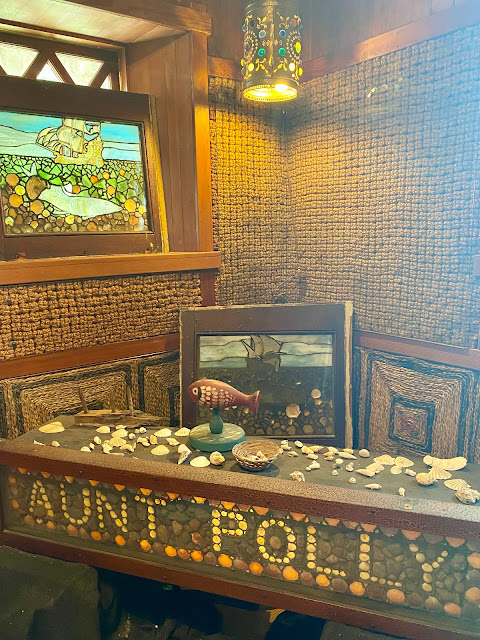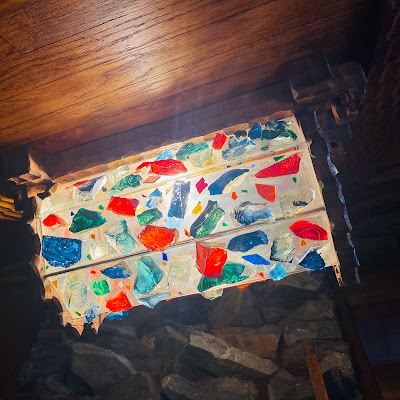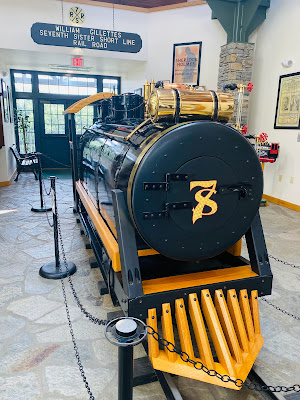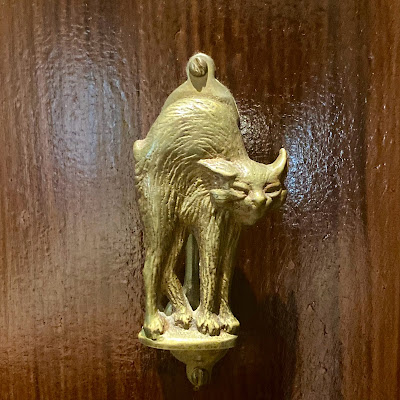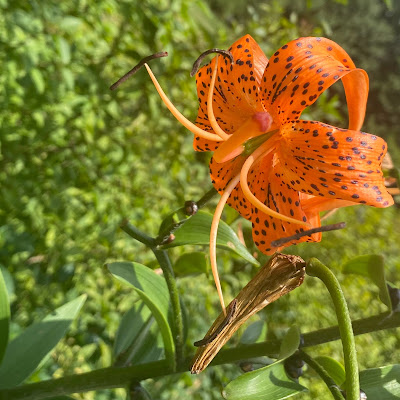When Randy suggested we blow off Providence to visit a castle, I was skeptical after seeing several so recently in Scotland. But none had the incredible back story of Gillette Castle, situated atop a hill. It's named for an American actor who helped extend the Sherlock Holmes brand by adapting Sir Conan Doyle's works for the stage and starring in them. William Gillette is the template for Basil Rathbone, whose movies popularized Sherlock even more in the 1940s, nearly half a century later.
A sign at the castle's entrance makes the Sherlock Holmes connection, using the deerstalker cap and bent pipe that became Gillette's iconic stage props.
Gillette called the place "7th Sister," after the Seven Sisters, a series of hills that increase in elevation along a stretch of the Connecticut River.
Gillette designed every detail of the castle. It's constructed mostly of locally quarried stone and white oak. Embedded (and Tiffany) glass provides flashes of kaleidoscopic color throughout the interior.
The installation of mirrors in the big room enabled Gillette to observe his guests while hidden from view, facilitating practical jokes such as locking up the bar after telling them to mix their own drinks.
Gillette cat-proofed the musical frogs and incense burners displayed on the hearth by cementing them in place. But he also added wooden fringe to the gaming table above to keep his kitties entertained.
A giant bull frog adorns the indoor patio.
Theatrical is as good a description as any for the decor, which includes owl andirons and painting the mortar purple.
Colorful sisal covers many of the castle's walls, enhancing the acoustics.
A shrine to "Aunt Polly," the houseboat where Gillette lived on the river below for five years during the construction of the 7th Sister fills, one room.
Unfortunately, Aunt Polly eventually sank to the bottom of the Connecticut River. You can see remnants of the wreck at low tide.
A monogrammed blanket covers a bed in one of the castle's two guest rooms.
Medieval castles inspired the doors which have a complicated latching system.
More embedded glass.
Two of my favorite works recall place mats I remember collecting from road trips with my parents in the late 50s and 60s.
Louis Wain, Victorian illustrator whose fanciful drawings of cats exponentially increased their popularity as pets, was a contemporary of Gillette's and likely a kindred spirit in the wackiness department. These vases are a rare example of Wain's ceramic work. In an interesting cosmic coincidence, Benedict Cumberbatch, who rose to fame after portraying Sherlock Holmes on television, plays Wain in a wonderful movie about the eccentric. Also falling into the stranger-than-fiction bucket, Busby Berkeley was Gillette's godson!
I have no why idea why this pitcher and glasses are displayed so prominently but they photographed really well.
Here's the front view of the Gillette Castle
. . . and an unobstructed view below. All the windows are paned.
Can you tell we really enjoyed our visit? Even Randy, who had been before and will no doubt take other guests from his home in New London.
Gillette was practical as well as whimsical. He built a miniature railroad to haul construction materials up to the 7th Sister. Helen Hayes took a ride as a little girl. Although Gillette was married briefly before a burst appendix killed his young wife, they had no children and he remained single. He left his estate to a family member who could sell it only if the potential buyer wasn't a "saphead," the exact term he used in his will. The state of Connecticut, where Gillette's father had been elected a senator not long before the Civil War, purchased the 7th Sister in 1943.
Note the name of the station.
You can picnic inside.
Afterward, Randy used the Chester/Hadlyme ferry to take us across the river for lunch. His driving skills have become a lot more confident since acquiring his Kia a year ago and acting as a superb guide for visiting friends.
Scottish castles may be a lot older and more imposing but few are as storied.
We dined at the Blue Oar overlooking the river, the perfect way to end our Connecticut visit.













